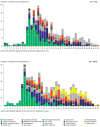Second Malignancies Following Childhood Cancer Treatment in Germany From 1980 to 2014
- PMID: 29960606
- PMCID: PMC6041965
- DOI: 10.3238/arztebl.2018.0385
Second Malignancies Following Childhood Cancer Treatment in Germany From 1980 to 2014
Abstract
Background: Because of improvements in cancer treatment, more than 80% of all children with cancer now survive at least five years from the time of diagnosis. As a result, late sequelae of cancer and its treatment have become more common, particularly second malignancies. We studied the current incidence of second malignancies among childhood cancer survivors in Germany.
Methods: This study is based on the cohort of the German Childhood Cancer Registry (Deutsches Kinderkrebsregister, DKKR). Persons given the diagnosis of a first malignancy at any time in the years 1980-2014 who were no more than 14 years old at the time of diagnosis and survived at least six months thereafter were included in the study. Cumulative incidences and hazard ratios were calculated, and comparisons with the general population were made with the aid of standardized incidence ratios (SIR).
Results: Among the 47 650 survivors included in the study, there were 1262 cases of second malignancies. After a follow-up interval of up to 35 years, the cumulative incidence of second malignancies was 8.27% (95% confidence interval [7.51; 9.03]). Second malignancies were more common in female patients (hazard ratio 1.29, [1.16; 1.44]) and in those who had had a systemic cancer as their initial malignancy (hazard ratio 1.22 [1.09; 1.36]). The SIR compared to the general population for the period 1955-2014 was 7.08 [6.42; 7.9] for female patients and 5.83 [5.27; 6.42] for male patients.
Conclusion: The cumulative incidence of second malignancies is 5.4% at 25 years and 8.3% at 35 years; these figures may be slight underestimates. The DKKR is an epidemiologic registry containing no data about treatment, so the effect of treatment on the risk of second malignancies could not be studied. The acquisition and evaluation of treatment data for the overall cohort is currently one of the main tasks for research on the late sequelae of childhood cancer. This may enable conclusions to be drawn about whether treatment strategies that have been introduced to lessen the risk of a second malignancy actually have the desired effect.
Figures


References
-
- Kaatsch P, Grabow D, Spix C. German Childhood Cancer Registry—annunal report 2016 (1980-2015) Institute for Medical Biostatistics, Epidemiology and Informatics (IMBEI) at the University Medical Center of the Johannes Gutenberg University Mainz 2016. www.kinderkrebsregister.de/dkkr/ergebnisse/jahresberichte.html. (last accessed on 13 April 2018)
-
- World Health Organization. World Health Organization. Geneva: 2013. International Classification of Diseases for Oncology (ICD-O) (3rd edition, 1st revision), 3rd ed.
-
- Choi D, Helenowski I, Hijiya N. Secondary malignancies in pediatric cancer survivors: perspectives and review of the literature. Int J Cancer. 2014;135:1764–1773. - PubMed
Publication types
MeSH terms
LinkOut - more resources
Full Text Sources
Other Literature Sources
Medical
Research Materials
